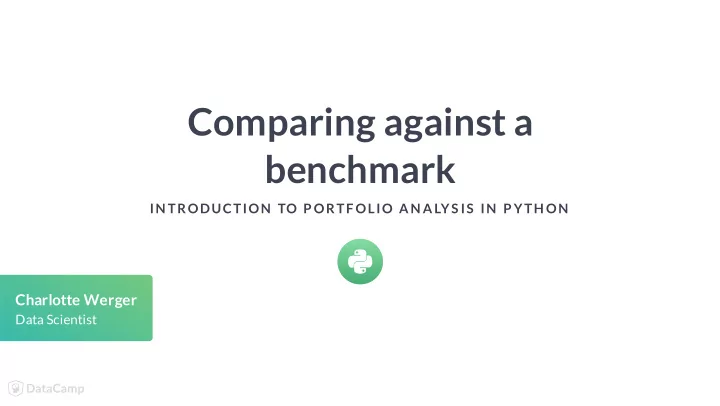

Comparing against a benchmark IN TRODUCTION TO P ORTF OLIO AN ALYS IS IN P YTH ON Charlotte Werger Data Scientist
Active investing against a benchmark INTRODUCTION TO PORTFOLIO ANALYSIS IN PYTHON
Active return for an actively managed portfolio Active return is the performance of an (active) investment, relative to the investment's benchmark. Calculated as the difference between the benchmark and the actual return . Active return is achieved by "active" investing, i.e. taking overweight and underweight positions from the benchmark. INTRODUCTION TO PORTFOLIO ANALYSIS IN PYTHON
Tracking error for an index tracker Passive investment funds, or index trackers , don't use active return as a measure for performance. Tracking error is the name used for the difference in portfolio and benchmark for a passive investment fund. INTRODUCTION TO PORTFOLIO ANALYSIS IN PYTHON
Active weights 1 Source: Schwab Center for Financial Research. INTRODUCTION TO PORTFOLIO ANALYSIS IN PYTHON
Active return in Python # Inspect the data portfolio_data.head() mean_ret var pf_w bm_w GICS Sector Ticker A 0.146 0.035 0.002 0.005 Health Care AAL 0.444 0.094 0.214 0.189 Industrials AAP 0.242 0.029 0.000 0.000 Consumer Discretionary AAPL 0.225 0.027 0.324 0.459 Information Technology ABBV 0.182 0.029 0.026 0.010 Health Care 1 Global Industry Classi�cation System (GICS) INTRODUCTION TO PORTFOLIO ANALYSIS IN PYTHON
Active return in Python # Calculate mean portfolio return total_return_pf = (pf_w*mean_ret).sum() # Calculate mean benchmark return total_return_bm = (bm_w*mean_ret).sum() # Calculate active return active_return = total_return_pf - total_return_bm print ("Simple active return: ", active_return) Simple active return: 6.5764 INTRODUCTION TO PORTFOLIO ANALYSIS IN PYTHON
Active weights in Python # Group dataframe by GICS sectors grouped_df=portfolio_data.groupby('GICS Sector').sum() # Calculate active weights of portfolio grouped_df['active_weight']=grouped_df['pf_weights']- grouped_df['bm_weights'] print (grouped_df['active_weight']) GICS Sector Consumer Discretionary 20.257 Financials -2.116 ...etc INTRODUCTION TO PORTFOLIO ANALYSIS IN PYTHON
Let's practice! IN TRODUCTION TO P ORTF OLIO AN ALYS IS IN P YTH ON
Risk factors IN TRODUCTION TO P ORTF OLIO AN ALYS IS IN P YTH ON Charlotte Werger Data Scientist
What is a factor? Factors in portfolios are like nutrients in food INTRODUCTION TO PORTFOLIO ANALYSIS IN PYTHON
Factors in portfolios Different types of factors: Macro factors: interest rates, currency, country, industry Style factors: momentum, volatility, value and quality INTRODUCTION TO PORTFOLIO ANALYSIS IN PYTHON
Using factor models to determine risk exposure 1 2 3 4 Source: https://invesco.eu/investment campus/educational papers/factor investing INTRODUCTION TO PORTFOLIO ANALYSIS IN PYTHON
Factor exposures df.head() date portfolio volatility quality 2015-01-05 -1.827811 1.02 -1.76 2015-01-06 -0.889347 0.41 -0.82 2015-01-07 1.162984 1.07 1.39 2015-01-08 1.788828 0.31 1.93 2015-01-09 -0.840381 0.28 -0.77 INTRODUCTION TO PORTFOLIO ANALYSIS IN PYTHON
Factor exposures df.corr() portfolio volatility quality portfolio 1.000000 0.056596 0.983416 volatility 0.056596 1.000000 0.092852 quality 0.983416 0.092852 1.000000 INTRODUCTION TO PORTFOLIO ANALYSIS IN PYTHON
Correlations change over time # Rolling correlation df['corr']=df['portfolio'].rolling(30).corr(df['quality']) # Plot results df['corr'].plot() INTRODUCTION TO PORTFOLIO ANALYSIS IN PYTHON
Rolling correlation with quality INTRODUCTION TO PORTFOLIO ANALYSIS IN PYTHON
Let's practice! IN TRODUCTION TO P ORTF OLIO AN ALYS IS IN P YTH ON
Factor models IN TRODUCTION TO P ORTF OLIO AN ALYS IS IN P YTH ON Charlotte Werger Data Scientist
Using factors to explain performance Factors are used for risk management. Factors are used to help explain performance. Factor models help you relate factors to portfolio returns Empirical factor models exist that have been tested on historic data. Fama French 3 factor model is a well-known factor model. INTRODUCTION TO PORTFOLIO ANALYSIS IN PYTHON
Fama French Multi Factor model = α + β MKT + β SMB + β HML R pf m s h − R MKT is the excess return of the market, i.e. R m f SMB (Small Minus Big) a size factor HML (High Minus Low) a value factor INTRODUCTION TO PORTFOLIO ANALYSIS IN PYTHON
Regression model refresher INTRODUCTION TO PORTFOLIO ANALYSIS IN PYTHON
Difference between beta and correlation INTRODUCTION TO PORTFOLIO ANALYSIS IN PYTHON
Regression model in Python import statsmodels.api as sm # Define the model model = sm.OLS(factor_data['sp500'], factor_data[['momentum','value']]).fit() # Get the model predictions predictions = model.predict(factor_data[['momentum','value']]) b1, b2 = model.params INTRODUCTION TO PORTFOLIO ANALYSIS IN PYTHON
The regression summary output # Print out the summary statistics model.summary() INTRODUCTION TO PORTFOLIO ANALYSIS IN PYTHON
Obtaining betas quickly # Get just beta coefficients from linear regression model b1, b2 = regression.linear_model.OLS(df['returns'], df[['F1', 'F2']]).fit().params # Print the coefficients print 'Sensitivities of active returns to factors: \nF1: %f\nF2: %f' % (b1, b2) Sensitivities of active returns to factors: F1: -0.0381 F2: 0.9858 INTRODUCTION TO PORTFOLIO ANALYSIS IN PYTHON
Let's practice! IN TRODUCTION TO P ORTF OLIO AN ALYS IS IN P YTH ON
Portfolio analysis tools IN TRODUCTION TO P ORTF OLIO AN ALYS IS IN P YTH ON Charlotte Werger Data Scientist
Professional portfolio analysis tools INTRODUCTION TO PORTFOLIO ANALYSIS IN PYTHON
Back-testing your strategy Back-testing: run your strategy on historic data and see how it would have performed Strategy works on historic data: not guaranteed to work well on future data -> changes in markets INTRODUCTION TO PORTFOLIO ANALYSIS IN PYTHON
Quantopian's pyfolio tool 1 Github: https://github.com/quantopian/pyfolio INTRODUCTION TO PORTFOLIO ANALYSIS IN PYTHON
Performance and risk analysis in Pyfolio # Install the package !pip install pyfolio # Import the package import pyfolio as pf # Read the data as a pandas series returns=pd.Series(pd.read_csv('pf_returns.csv') returns.index=pd.to_datetime(returns.index) # Create a tear sheet on returns pf.create_returns_tear_sheet(returns) # If you have backtest and live data pf.create_returns_tear_sheet(returns, live_start_date='2018-03-01') INTRODUCTION TO PORTFOLIO ANALYSIS IN PYTHON
Pyfolio's tear sheet INTRODUCTION TO PORTFOLIO ANALYSIS IN PYTHON
Holdings and exposures in Pyfolio # define our sector mappings sect_map = {'COST': 'Consumer Goods', 'INTC': 'Technology', 'CERN': 'Healthcare', 'GPS': 'Technology', 'MMM': 'Construction', 'DELL': 'Technology', 'AMD': 'Technology'} pf.create_position_tear_sheet(returns, positions, sector_mappings=sect_map) INTRODUCTION TO PORTFOLIO ANALYSIS IN PYTHON
Exposure tear sheet results INTRODUCTION TO PORTFOLIO ANALYSIS IN PYTHON
Let's practice! IN TRODUCTION TO P ORTF OLIO AN ALYS IS IN P YTH ON
Recommend
More recommend